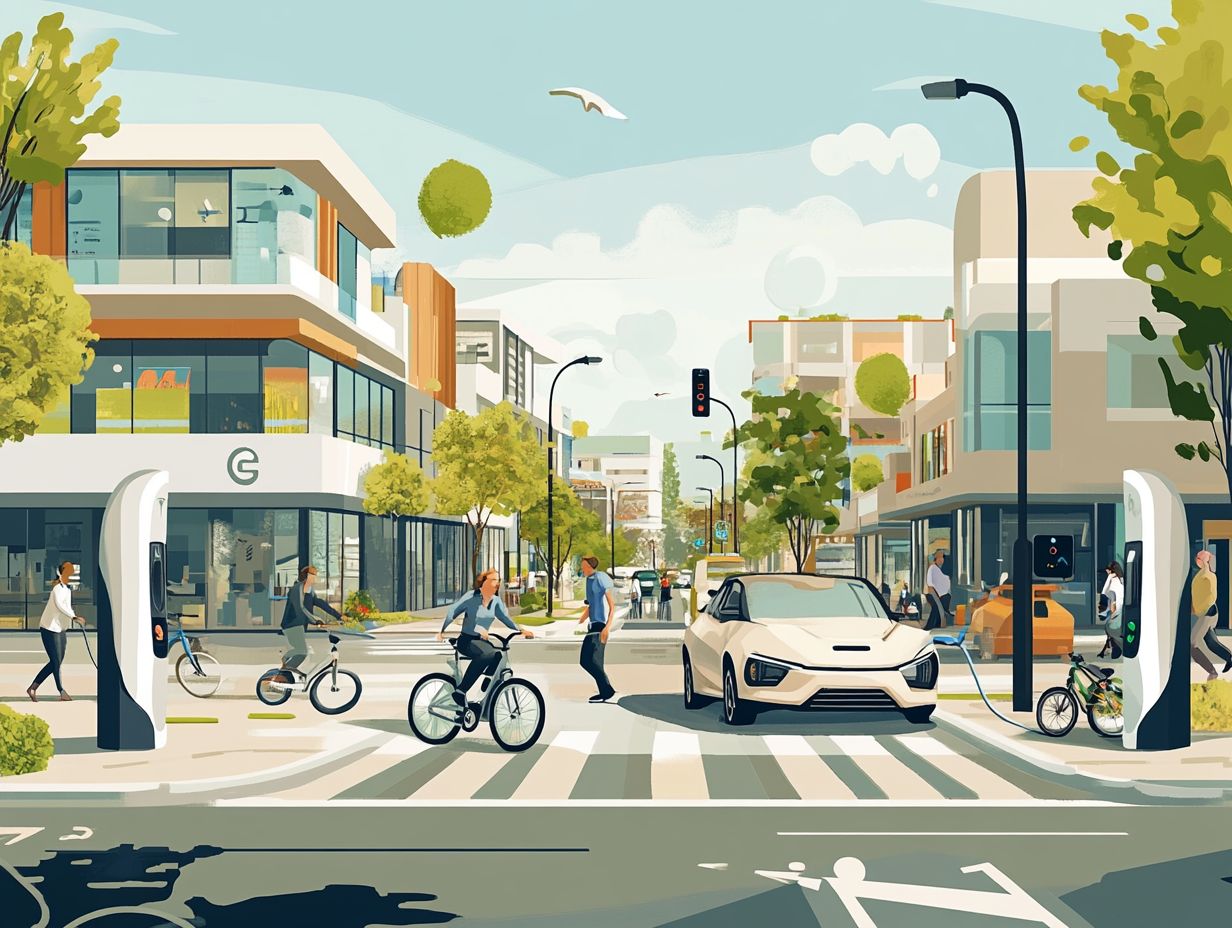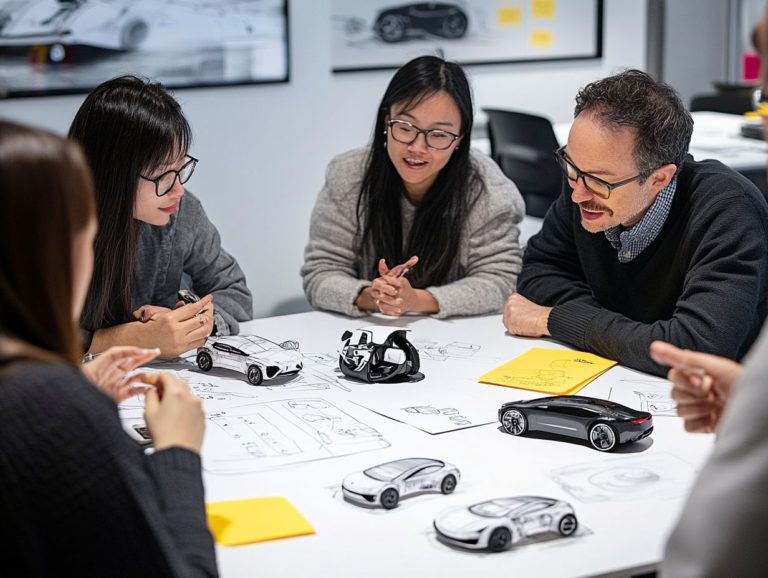5 Ways Electric Vehicles are Changing Communities
Electric vehicles (EVs) are reshaping communities in profound ways. They cut down carbon footprints and improve air quality, making their benefits truly impressive.
As cities refine their infrastructure and transportation systems, new job opportunities are blossoming in the EV sector. However, challenges still exist when it comes to widespread adoption.
This article explores how EVs are transforming environments and how communities can embrace this shift toward a cleaner, more sustainable future.
Join us as we discover key advantages, potential hurdles, and innovative solutions that encourage the integration of electric vehicles into daily life.
Contents
- Key Takeaways:
- 1. Reducing Carbon Footprint
- 2. Improving Air Quality
- 3. Decreasing Noise Pollution
- 4. Creating Jobs in the EV Industry
- 5. Changing Infrastructure and Transportation Systems
- What Are the Main Advantages of Electric Vehicles?
- Frequently Asked Questions
- What are electric vehicles and how are they changing communities?
- How are electric vehicles reducing air pollution in communities?
- What is the impact of electric vehicles on the environment?
- How are electric vehicles promoting sustainable energy in communities?
- Are there any economic benefits of electric vehicles for communities?
- How are electric vehicles revolutionizing transportation in communities?
Key Takeaways:

- Electric vehicles significantly reduce carbon footprints, making them vital in combating climate change.
- By replacing gas-powered cars, electric vehicles improve air quality and decrease pollution in communities.
- Electric vehicles run quietly, reducing noise pollution and creating more enjoyable urban environments.
1. Reducing Carbon Footprint
Electric vehicles are crucial for reducing the carbon footprint linked to traditional transportation. Embracing an electric lifestyle helps lower greenhouse gas emissions and promotes a more sustainable future.
This transition tackles climate change directly and enhances energy efficiency in transportation, contributing to cleaner air for your community.
In urban areas, reducing reliance on gas-powered vehicles leads to better air quality and less noise. In rural regions, expanding charging infrastructure increases accessibility and drives economic growth.
Ultimately, adopting electric vehicles is essential for achieving long-term environmental goals and aligns with the growing global focus on sustainability.
2. Improving Air Quality
The widespread adoption of electric vehicles is a crucial step in enhancing air quality, particularly in urban areas struggling with pollution that threatens health, especially for low-income households.
Switching to EVs contributes to significant reductions in harmful emissions like nitrogen oxides and particulate matter, which are major causes of respiratory diseases. This shift addresses immediate health concerns and supports long-term public health objectives, especially in areas that have faced environmental neglect.
For disadvantaged communities, better air quality means fewer hospital visits, improved overall health, and a more equitable living environment. Embracing cleaner transportation aligns beautifully with broader environmental justice initiatives, ensuring everyone can breathe easier while striving for a sustainable future.
3. Decreasing Noise Pollution
Electric vehicles are noticeably quieter than traditional gasoline-powered cars, leading to a significant reduction in noise pollution, particularly in bustling urban areas. This shift creates a more serene environment and enhances overall well-being.
The decrease in noise fosters a peaceful atmosphere, contributing to healthier living conditions. Research shows that neighborhoods with lower vehicular noise often see property values increase sometimes by as much as 20% as tranquility becomes a desirable feature for potential homeowners.
Reduced noise also lowers stress levels and improves mental health among residents, promoting a vibrant lifestyle. As cities increasingly adopt electric vehicles, they can look forward to enhanced quality of life, making urban areas more appealing to families and individuals seeking a harmonious living experience.
Get involved with electric vehicle initiatives in your community to help shape a sustainable future and understand how electric vehicles can influence policy change.
4. Creating Jobs in the EV Industry

The electric vehicle industry is experiencing rapid growth, opening up a wealth of job opportunities in sectors like manufacturing, maintenance, and infrastructure development. This growth drives economic progress and enriches the electric vehicle workforce.
As the appetite for electric vehicles continues to soar, roles tied to domestic manufacturing are becoming increasingly crucial. Positions in assembly, battery production, and quality control are essential for ensuring that vehicles uphold rigorous standards.
The expansion of charging infrastructure paves the way for employment in planning, installing, and servicing charging stations. This is especially important in rural areas where these facilities are often lacking.
These emerging roles advance a cleaner energy future and strengthen local economies by providing stable employment. They also encourage investment in sustainable technologies.
5. Changing Infrastructure and Transportation Systems
As electric vehicle adoption accelerates, significant changes are needed for existing infrastructure and transportation systems. This includes developing a comprehensive charging network for a smooth transition to EVs across communities.
This evolution enhances convenience for users. It also ensures fair access to vehicles, especially in underserved areas.
A robust charging network gives power to individuals in both urban centers and rural locales. This makes it easier for everyone to embrace the shift to electric vehicles.
State and federal policies play a pivotal role in shaping this infrastructure. Incentives can stimulate investments by encouraging the installation of charging stations where they are most needed.
By strategically positioning these resources, communities can foster sustainable mobility solutions. This addresses the growing demand for clean transportation options.
What Are the Main Advantages of Electric Vehicles?
Electric vehicles offer a wealth of advantages that can significantly enhance your lifestyle and the environment. By reducing air pollution, they deliver notable health benefits, especially in urban areas plagued by smog.
You ll breathe easier and contribute to a decline in respiratory illnesses, improving public health for everyone. The savings are impressive as well.
Research indicates that electric vehicle owners can save up to $800 each year on fuel costs alone. This is a substantial relief for those navigating tight budgets.
Additionally, with maintenance expenses typically around 30% lower than those for gas vehicles, you can allocate your finances with greater ease.
Embracing electric vehicles promotes environmental justice. Communities often burdened by pollution will see marked improvements in air quality.
This paves the way for a healthier, fairer living environment for all. Choosing electric isn t just a personal choice; it s a step toward a brighter future for everyone.
How Can Communities Benefit from the Adoption of Electric Vehicles?
Communities can reap significant benefits from embracing electric vehicles, including improved public health and decreased air pollution. Additionally, exploring ways to reduce charging costs for EVs can further enhance these advantages.
Local economic development will also get a boost through job creation in the EV sector. Transitioning to electric mobility can lead to more green spaces and cleaner urban environments.
This greatly enhances your quality of life. As clean-energy vehicles become more common on the roads, harmful emissions will drop.
This results in healthier living conditions and more opportunities for outdoor activities. Educational institutions will thrive as local governments establish programs to train the workforce in electric vehicle maintenance and manufacturing.
This initiative equips individuals with valuable skills and cultivates innovation hubs. These contribute to the community s economic resilience and vitality.
What Are the Barriers to Widespread Adoption of Electric Vehicles?

Despite the clear advantages of electric vehicles, several barriers stand in the way of their widespread adoption. High initial prices, inadequate charging infrastructure, and public misconceptions about EV performance can complicate your journey to going electric.
Low-income households feel these challenges particularly hard due to the upfront costs of electric vehicles, which often seem out of reach compared to traditional options. The lack of robust charging networks can make ownership seem impractical for those living in urban areas or lacking access to home charging.
Misinformation surrounding fear of running out of battery and battery longevity can also discourage potential buyers. This creates a cycle of skepticism that spans various demographics.
To tackle these issues, targeted initiatives like financial incentives, community charging solutions, and comprehensive educational campaigns are essential. These efforts can significantly enhance accessibility and cultivate a more positive perception of electric vehicles across all segments of the population.
What Are the Potential Solutions to Overcome These Barriers?
To truly promote electric vehicle adoption, consider implementing effective strategies like enhancing charging infrastructure, offering policy incentives, and providing consumer education to dispel myths surrounding EV usage.
These measures directly tackle common barriers that potential buyers encounter, particularly fear of running out of battery and scarcity of accessible charging stations. By investing in a robust network of fast chargers and offering incentives such as tax rebates or grants for EV purchasers, you can alleviate financial concerns and inspire consumers to make the switch.
Community initiatives can play a crucial role by organizing informational workshops and test-driving events. These events allow individuals to experience firsthand the benefits and practicality of electric vehicles.
Educational campaigns designed to demystify the technology will empower consumers, reassuring them that choosing an EV is a practical and sustainable decision.
How Can Communities Encourage the Use of Electric Vehicles?
Communities can significantly influence electric vehicle adoption through targeted initiatives and enhancing public transportation options. Additionally, local communities can support EV sustainability by championing federal efforts to boost EV infrastructure development.
Some neighborhoods are taking exciting steps to organize awareness campaigns that highlight the environmental benefits of electric vehicles while tackling common misconceptions. Additionally, various local governments are stepping up by offering enticing incentives for new EV buyers, such as tax breaks or rebates, as detailed in how EVs are shaping urban mobility, making the shift to greener transportation more accessible for everyone.
Partnerships with local businesses can greatly enhance convenience by installing charging stations at shopping centers and workplaces. This collaborative effort between local governments, businesses, and residents is crucial in creating a robust electric vehicle ecosystem that meets community needs while paving the way for a sustainable future.
Frequently Asked Questions
What are electric vehicles and how are they changing communities?

Electric vehicles are cars that run on electricity instead of gasoline. They are changing communities by reducing air pollution, promoting sustainable energy, and revolutionizing transportation.
How are electric vehicles reducing air pollution in communities?
Electric vehicles produce zero emissions, meaning they do not release harmful pollutants into the air like traditional gasoline cars. This helps improve air quality in communities and reduce the negative health effects of air pollution.
What is the impact of electric vehicles on the environment?
Electric vehicles are much friendlier to the environment than traditional cars. They use clean energy sources and emit fewer greenhouse gases, helping to combat climate change and create a healthier planet.
How are electric vehicles promoting sustainable energy in communities?
Electric vehicles can be charged with renewable energy sources like solar and wind power. This shift reduces our dependence on fossil fuels and supports sustainable energy production, which can lower electricity bills for families.
Are there any economic benefits of electric vehicles for communities?
Yes, electric vehicles offer various economic benefits. They can lower fuel expenses for individuals and businesses, create jobs in the electric vehicle industry, and cut healthcare costs linked to air pollution.
How are electric vehicles revolutionizing transportation in communities?
Electric vehicles are reshaping how we think about transportation. They operate quietly, need less maintenance, and are cheaper to own compared to traditional cars.
The rise of electric buses and public charging stations is making electric transportation more accessible and convenient for everyone.






